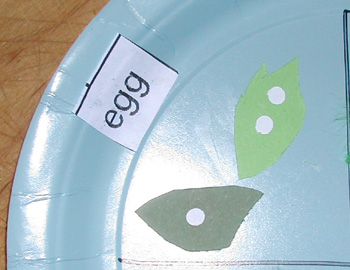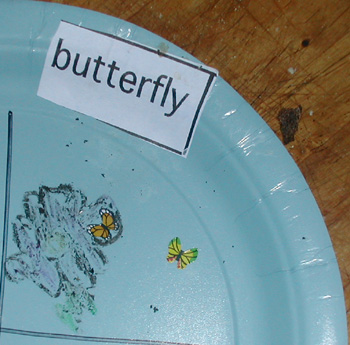Younger offspring: (brandishing a decorated and labeled paper plate) You’re going to blog about this on Friday.
Dr. Free-Ride: I am?
Younger offspring: Yes! It has to do with science, and I made it.
Dr. Free-Ride: (pretending to think it over) Well, I don’t know …
Younger offspring: And this way, you don’t have to get us to draw you pictures on Friday morning when we’re supposed to be getting ready for school.
Dr. Free-Ride: Ah, so you’re saving me time? OK, I’m convinced.

The younger Free-Ride offspring’s kindergarten class has been studying insect lifecycles. It’s one of those Spring-y activities that teachers seem to like.

Indeed, the kindergarten teacher ordered a bunch of pre-butterfly-stage butterflies for younger offspring’s class to observe. (I haven’t been able to establish with certainty whether they started with a mixed set, or all caterpillars, or all pupae. Kindergarteners, it turns out, don’t always keep track of these details for the purposes of transmitting accurate information to their parents.)
Anyway.

Dr. Free-Ride: Can you explain what’s going on here to me?
Younger offspring: First a butterfly lays an egg.
Elder offspring: It’s a good idea to lay it somewhere it won’t be eaten.
Younger offspring: (patiently ignoring elder offspring’s interjection) Then the egg hatches and there’s a caterpillar. The caterpillar finds something yummy like leaves and eats and eats and eats until it’s a lot bigger than it was when it came out of the egg.
Dr. Free-Ride: With coddling moths, the preferred food seems to be apples rather than leaves.

Younger offspring: The next stage is the pupa. The caterpillar makes a chrysalis and is in there for a while.
Elder offspring: I wonder if the chrysalis is kind of like camouflage
Younger offspring: Huh?
Elder offspring: They look kind of like leaves or seedpods. They definitely don’t look like caterpillars or like butterflies, so the animals that would probably want to eat caterpillars or butterflies wouldn’t bother with eating the chrysalis because they don’t look anything like what they want to eat.

Younger offspring: Finally, a butterfly comes out of the chrysalis, and then that butterfly could lay an egg and the cycle starts again.
Dr. Free-Ride: Thank you for explaining that to me.
Younger offspring: You’re welcome.
Dr. Free-Ride: I just thought of something interesting while [elder offspring] was talking about critters that might want to eat caterpillars or butterflies.
Elder offspring: What?
Dr. Free-Ride: Well, remember earlier when you guys were imitating some of the birdsongs we were hearing on the way to school?
Younger offspring: Yes.
Dr. Free-Ride: I was remembering that there’s a way some butterflies “imitate” other butterflies, except they don’t imitate how they sound, they imitate how they look.
Younger offspring: Why do they do that?
Dr. Free-Ride: There are some butterflies that are extremely yucky to eat, if you’re a bird or another animal who eats butterflies. Those animals learn to avoid the yucky-tasting butterflies.
Younger offspring: And they try to eat the yummy butterflies.
Dr. Free-Ride: Exactly. But some of the yummy butterflies manage to avoid getting eaten because they look enough like the yucky-tasting butterflies.
Elder offspring: How do they do that?
Dr. Free-Ride: That’s a good question! Changing how you look is harder for a butterfly than it is for you kids — they don’t have face paints or costumes.
Elder offspring: So how do they do it?
Dr. Free-Ride: OK, let’s say two yummy-tasting butterflies have ten butterfly children. Just like in human families, they kids don’t all look exactly alike. Some of the butterfly-kids look like most of the other yummy-tasting butterflies, but maybe some have patterns on their wings, or colors, that look different from their parents’. They might even look a tiny bit like the patterns and colors of a yucky-tasting butterfly.
Younger offspring: And then what happens?
Dr. Free-Ride: Along comes a hungry bird.
Younger offspring: Uh oh!
Dr. Free-Ride: But the bird’s probably not hungry enough to eat all the butterfly kids. Which butterfly kids will the bird eat?
Elder offspring: The ones that look the most like the normal yummy butterflies.
Dr. Free-Ride: And which butterfly kids is the bird most likely not to eat?
Elder offspring: The ones that look like they might taste yucky, because they look a little bit like the yucky-tasting butterflies.
Dr. Free-Ride: That’s right. And it’s the butterfly kids who don’t get eaten by the birds that get to lay eggs and have kid butterflies of their own. If some of those butterflies who looked a little yucky have ten kids, again, these kids will probably not look exactly the same as each other. Some may look a little yucky, like their parents, some may look pretty yummy, like their grandparents, and some may look even more like the butterflies that are actually yucky than their parents do.
Elder offspring: And the hungry birds will probably avoid the kids that look more yucky and eat the kids who look more yummy.
Younger offspring: And the butterfly kids that look more yucky and don’t get eaten will lay eggs —
Elder offspring: And maybe some of those butterfly kids will look even yuckier, and birds definitely won’t want to eat those!
Dr. Free-Ride: With enough generations of this, you may even get delicious butterflies that look almost exactly like the butterflies that taste terrible.
Elder offspring: Cool!
Dr. Free-Ride: In case anyone asks? That’s evolution.

I think I know a few fanatical religious people that could use a simple explanation such as this.
Beautifully written, thanks.
Janet,
That’s how evolution should be explained to the ID people. And now I really have a dilemma: do I nominate you for sex education teacher of the year or evolution biology teacher of the year 😉
Janet:
Wow, that’s an amazing job explaining that to kids! I tried to do something similar with my daughter, but all I managed to do was make her confused. (She now thinks that grandma and grandpa used to sort-of like monkeys.)
I can’t wait for a flood of comments telling you you’re going to hell for indoctrinating poor children who should be learning about Jesus.
I’m just here to commend the younger sprog for planning ahead. Let’s hope school doesn’t educate the initiative out of her.
Funny, how little difference there is between teaching evolution to kids and to adults LOL!
Jim Mallet has some nice pages about mimicry (including photos).
Bob
Now chaos theory?
Nice post!